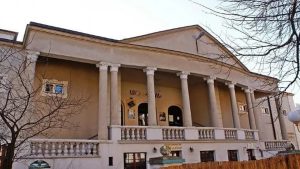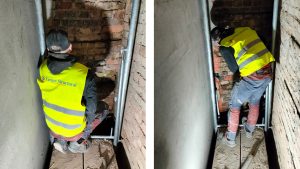
Arkadiusz Pękacz, Regional Director, Warsaw, Poland
Historic Preservation
Poland is a nation defined by its incredible architectural legacy. From medieval town squares to grand interwar landmarks, these buildings are more than just structures—they are tangible pieces of our history. For professionals dedicated to preserving this heritage, every project presents a unique challenge: how do we ensure a building’s stability for the next century without erasing the story of the last?
Our Polish branch, backed by decades of expertise from our UK head office, specializes in answering this exact question. We believe that modern engineering and Historic conservation must work hand-in-hand. We were recently honored to collaborate with APP PROJEKT on vital structural repairs at the beloved Apollo Cinema in Poznań, a perfect example of modern Masonry Reinforcement being used to secure an architectural icon.


The Weight of History: Why Traditional Repairs Were not an Option
The Apollo Cinema, located in the vibrant heart of Poznań, holds nearly two centuries of history. It began its life in 1846 as part of a bustling shopping arcade before being formally established as a cinema after World War I, eventually becoming the city’s largest movie house in the interwar period. Even after a beautiful Art Deco-inspired renovation in 2005, the structure remains a testament to enduring Polish culture.
However, time and continuous use take their toll. Like all older masonry buildings, the Apollo’s original brick walls began to exhibit signs of movement. Structural engineers identified significant stepped and vertical cracks in the unreinforced brickwork. These were not cosmetic issues; they were clear indications of structural stress caused by long-term differential settlement and environmental factors.
For a building with such deep cultural significance and a history of continuous operation, the remediation strategy had to be non-negotiable on two points: it had to be permanent, and it had to be non-destructive. Traditional approaches, which often involve large-scale demolition and rebuilding of wall sections, were deemed too invasive, too disruptive to the cinema’s operations, and fundamentally counter to the principles of Historic Preservation. The need was clear: a sophisticated, localised, and concealed method for Building conservation that could stabilise the walls and redistribute structural loads without affecting the building’s cherished aesthetics.
The Modern Answer: Precision Structural Stitching
In partnership with the structural design team, we proposed using our proprietary Bar Flex stainless steel helical bar system. This solution is engineered specifically for non-invasive structural repair and is a champion of Historic conservation principles. Rather than replacing the cracked masonry, we proposed integrating high-tensile reinforcement directly into the existing mortar lines.
The solution focused on three key engineering benefits:
- Tensile Strength Where It’s Needed: Masonry is incredibly strong in compression but weak in tension. Cracking occurs when the brickwork is pulled apart. Our 6mm Bar Flex provide immense tensile strength, effectively acting as internal tendons to hold the damaged masonry together.
- Structural Stitching: The objective was to structurally ‘stitch’ the separated sections of the brickwork, transforming discontinuous, cracked panels back into cohesive, load-bearing units. This process allows the wall to once again act as a single, structurally sound element, spanning and bridging the areas of weakness.
- Invisible and Permanent: By embedding the Bar Flex into the existing mortar beds with a specialised grout manufactured by Target Fixings Bond Flex., the repair is completely hidden upon completion. The result is a permanent stabilisation that preserves every millimetre of the historic brick face—a vital requirement for sensitive heritage projects.
This high-performance Masonry Reinforcement methodology provided APP PROJEKT with a durable, certified, and aesthetically sympathetic solution, offering a low-impact and highly cost-effective alternative to mass replacement.
From Theory to Reality: The Skill of the Polish Contractor Team


The implementation phase required not just quality materials, but skilled hands. The installation was managed by my specialist Polish Contractor team Target Structural Poland, whose expertise is honed in handling the unique challenges of historical European architecture. The success of the Apollo Cinema project depended entirely on their precision and dedication.
The process unfolded systematically:
- Preparation: Mortar beds were carefully raked out to a precise depth, extending a full 500mm beyond the extent of the visible cracking to ensure comprehensive load redistribution.
- Grout Injection: Channels were meticulously cleared and prepared to receive a specialised thixotropic, non-shrink cementitious grout Bond Flex.. The thixotropic property of the grout is essential; it flows readily into every microscopic void yet holds its shape, ensuring the Bar Flex is perfectly encapsulated.
- Bar Flex Placement: Nearly 100 metres of the 6mm Bar Flex reinforcement were carefully pressed into the wet grout. The helical profile is essential here, as it maximises the mechanical key between the Bar Flex and the Bond Flex., ensuring maximum load transfer capacity.
The entire process was executed with minimal noise and dust, allowing the cinema to continue its vital cultural function with maximum efficiency. Once the Bond Flex. cured, the joints were re-pointed to match the surrounding historic brickwork, making the structural intervention completely invisible. This project is a testament to the skill and dedication of my Polish Contractor teams who execute these complex Building conservation strategies every day.
We are proud to champion solutions that not only respect the past but guarantee the structural security of Polish landmarks for the future.
If you have any masonry reinforcement issues here in Poland skontaktuj się z nami today!
 Angielski
Angielski 
Comments are closed